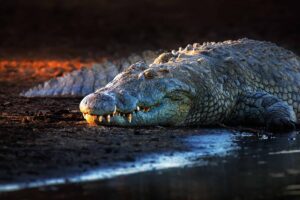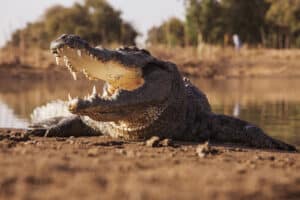Lurking in waters around the world, the crocodile is a semi-aquatic reptile, with a fearsome reputation as a top apex predator. Crocodiles are the largest reptiles in the world and have the greatest bite force of any living animal. But just how strong is the bite force of a crocodile? Let’s dive in!
The Background on Crocodile Species
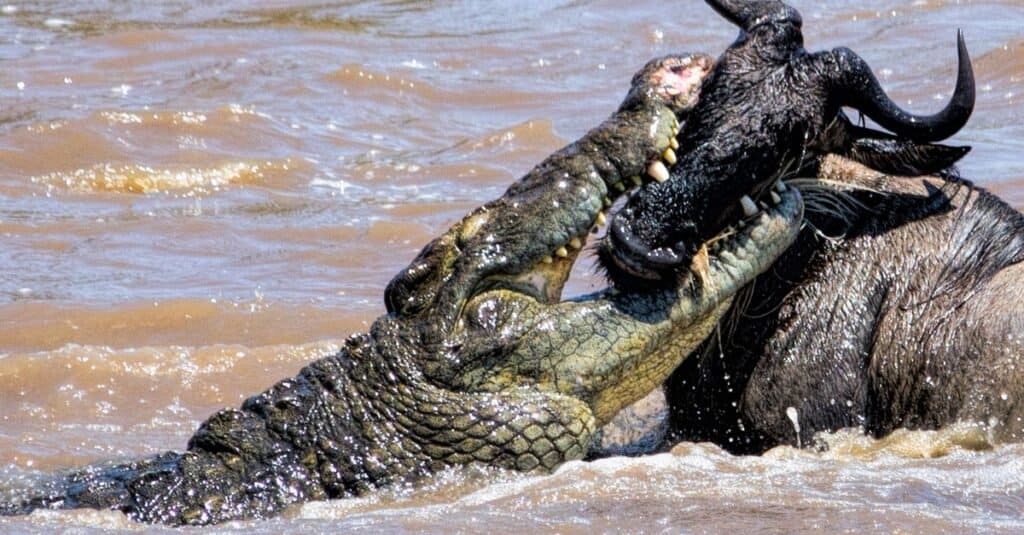
A wildebeest being attacked and killed by a crocodile. Crocodiles have been around since the age of the dinosaurs.
©Phil Hyde/Shutterstock.com
Prehistoric-like, they are one of the closest animals comparable to modern-day dinosaurs and have roamed the earth for over 240 million years. Inhabiting lakes, rivers, wetlands, and other bodies found in water, they are found across the globe in Africa, Asia, Australia, and America.
Crocodiles have the strongest bite force of any animal today. They are large and powerful, high at the top of the food chain. They have evolved to be one of the best apex predators in the wild with keen hearing, smell, and eyesight. Their mouths are large with 4 inch sharp teeth capable of gripping some of the slipperiest of prey.
There are around 24 species of Crocodilia in the world, separated into 3 different families, Alligatoridae, Crocodylidae, and Gavialidae. All crocodiles are capable of producing massive amounts of force with their bite, but some are better at it than others.
Many species of crocodiles rank high in how hard they can bite, and the saltwater crocodile has the greatest of them all. Along with their strong bites, there are a lot of interesting things to learn about this species.
What Crocodile Has The Largest Bite Force?

The largest, living reptile documented by science, the saltwater crocodile ambushes its prey before drowning it or swallowing it whole.
©Pius Rino Pungkiawan/Shutterstock.com
The saltwater crocodile has the greatest bite force of all animals with it measuring at 3,700 psi. The bite was measured by Dr. Gregory Erickson, a professor at Florida State University who studied the bite forces of all species of crocodile. The bite was taken from a 17ft Saltwater crocodile using a device placed at the end of a stick to measure force.
Dr. Erickson studied multiple species of crocodiles and discovered that saltwater crocodiles have the largest bite force, but he also analyzed other species and the similarities between them. Larger saltwater crocodiles may be able to produce a stronger bite, as some can reach up 23 feet and weigh over 2,000 lbs.
A crocodile’s species size is correlated with the amount of bite force they are able to produce. All species of crocodiles are designed to have a deadly bite but smaller crocs will produce a smaller bite force. When measured pound for pound they are found to have similar bite force. The size of the crocodile is directly correlated with the force produced.
Ranking Crocodile Bite Force from Highest to Lowest
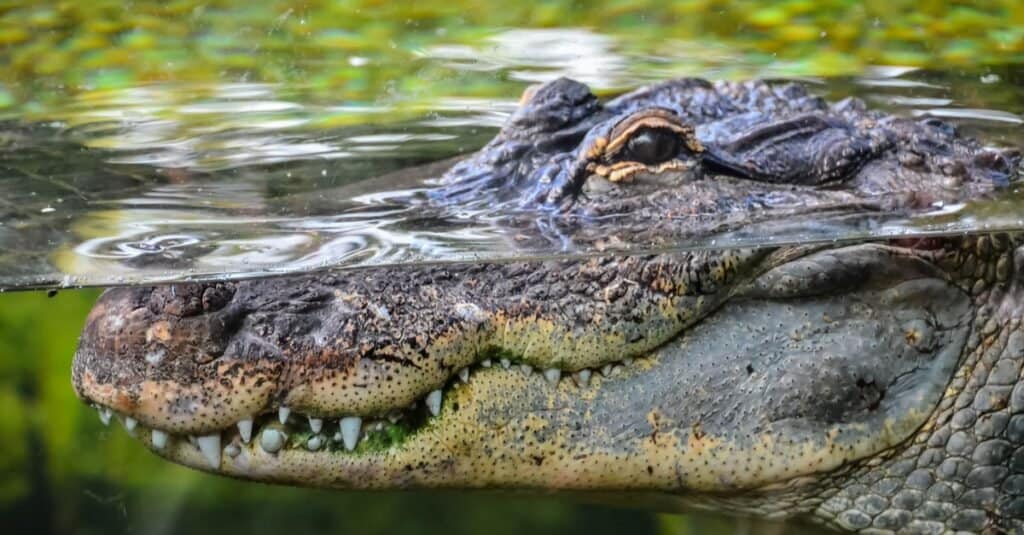
A big crocodile waiting for its prey just below the surface.
©underworld/Shutterstock.com
Bites of different species range from 500 to 4000 psi. Here are all the crocodile’s species ranked by the bite force they produced, with the greatest at the top:
- Saltwater crocodile
- Mugger
- Orinoco Crocodile
- New Guinea crocodile
- American Alligator
- Morelet’s crocodile
- American Crocodile
- Siamese crocodile
- Malay Gharial
- Philippine Freshwater Crocodile
- Nile Crocodile
- Black Caiman
- African Slender-snouted crocodile
- Cuban Crocodile
- Indian Gharial
- Dwarf Crocodile
- Spectacled Caiman
- Australian Freshwater Crocodile
- Broad-nosed Caiman
- Smooth-fronted caiman
- Chinese Alligator
- Yacare Caiman
- Cuvier’s Dwarf Caiman
Snout size and body structure have less of an impact on bite force than the weight and size of the crocodile. A measuring device was used to gather each crocodile’s bite force. Some studies have the Nile crocodile as having the strongest bite force in the world, but saltwater crocodiles are able to grow bigger, heavier, and have more muscle.
With the research and data taken from this study researchers have been able to find accurate and informative data about the bite force of each crocodile from today and in the past. With the varying size of each crocodile, the bite force produced will vary depending on the animal.
Why Do Crocodiles Have Such A Powerful Bite Force?
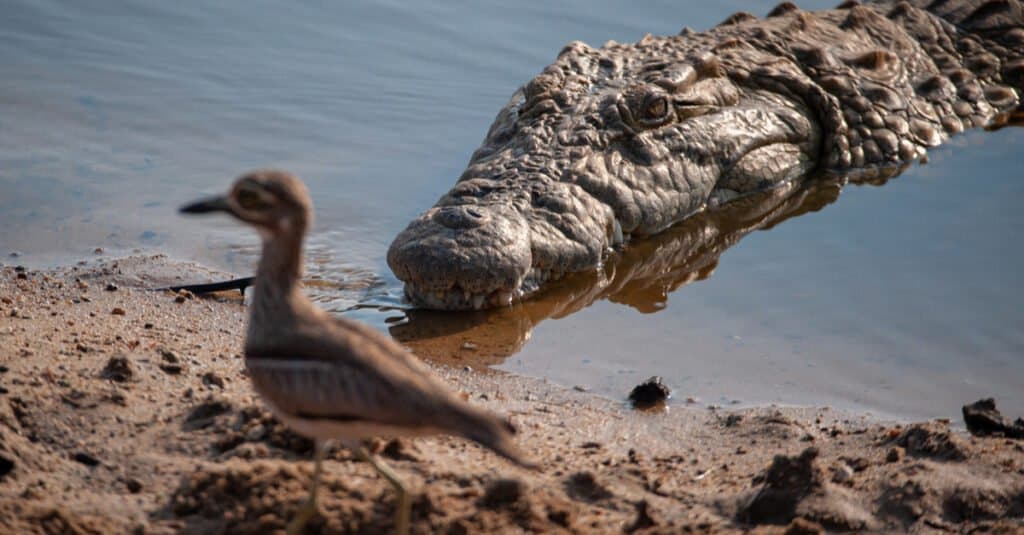
The Nile crocodile is an agile predator that can wait for hours, days, or even weeks to ambush its prey.
©Rudi Hulshof/Shutterstock.com
Crocodiles have always fascinated scientists, due to their amazing bite that scales with size. The secret behind their powerful bite is a second jaw joint that helps enhance the force of their bite. The second joint in their jaw helps distribute force and hold onto prey. This joint is found in all species and comes from years of evolution.
Studying their jaws can help humans understand their own since we have a similar function and design of their second joint. Common problems like arthritis and lockjaw can be better understood as we continue to learn about a crocodile’s bite.
Crocodiles’ jaws are meant for closing, so it is possible to hold their mouth shut with your bare heads. Like all jaws, the muscles to open are relatively weak compared to their ability to bite down.
How Do Crocodiles Use Their Strong Bite?
The main use of a crocodile’s bite is for hunting and consuming prey. As aquatic creatures, crocodiles survive on marine life, but bigger species are able to successfully prey on land animals. As carnivores, they eat only meat found in their local habitat. Fish, large mammals, and dead animals are common foods enjoyed by most species of crocodiles.
Crocodiles are apex predators and elite hunters. They will drag prey into the water to drown them and some species can swim up to 20 mph. When crocodiles get ahold of prey, they will perform a spinning maneuver to dismember prey, sometimes called the “death roll.” Producing a large amount of force with their bite, once a croc gets ahold of prey it is hard to get them to let go.
How Do Learning About Crocodiles Bite Help Us

An illustration of
Deinosuchusattacking a dinosaur
©Elenarts/Shutterstock.com
As scientists study crocodiles’ bite force they are able to learn about our own jaws and species that are now extinct. Crocodiles are one of the earth’s oldest species and have roamed the earth for millions of years.
Two species of crocodiles, the Deinosuchus and Purussaurus were some of the largest crocodile species in the world, reaching up to 33 feet. Other species can get even longer. With fossil records, we have been able to study them, but the greatest source of information has been the crocodiles of today.
The Deinosuchos had an estimated bite force of around 100,000 Newtons and the Purussaurus had a bite force of 69,000 Newtons! Through studying a crocodile’s bite force we have been able to scale and find out how powerful these exciting species were. Crocodiles are feared today and have the strongest bite force found, but they have been a dominant species preying on animals for longer than humans have existed.
The photo featured at the top of this post is © iStock.com/SteveByland
Thank you for reading! Have some feedback for us? Contact the AZ Animals editorial team.




